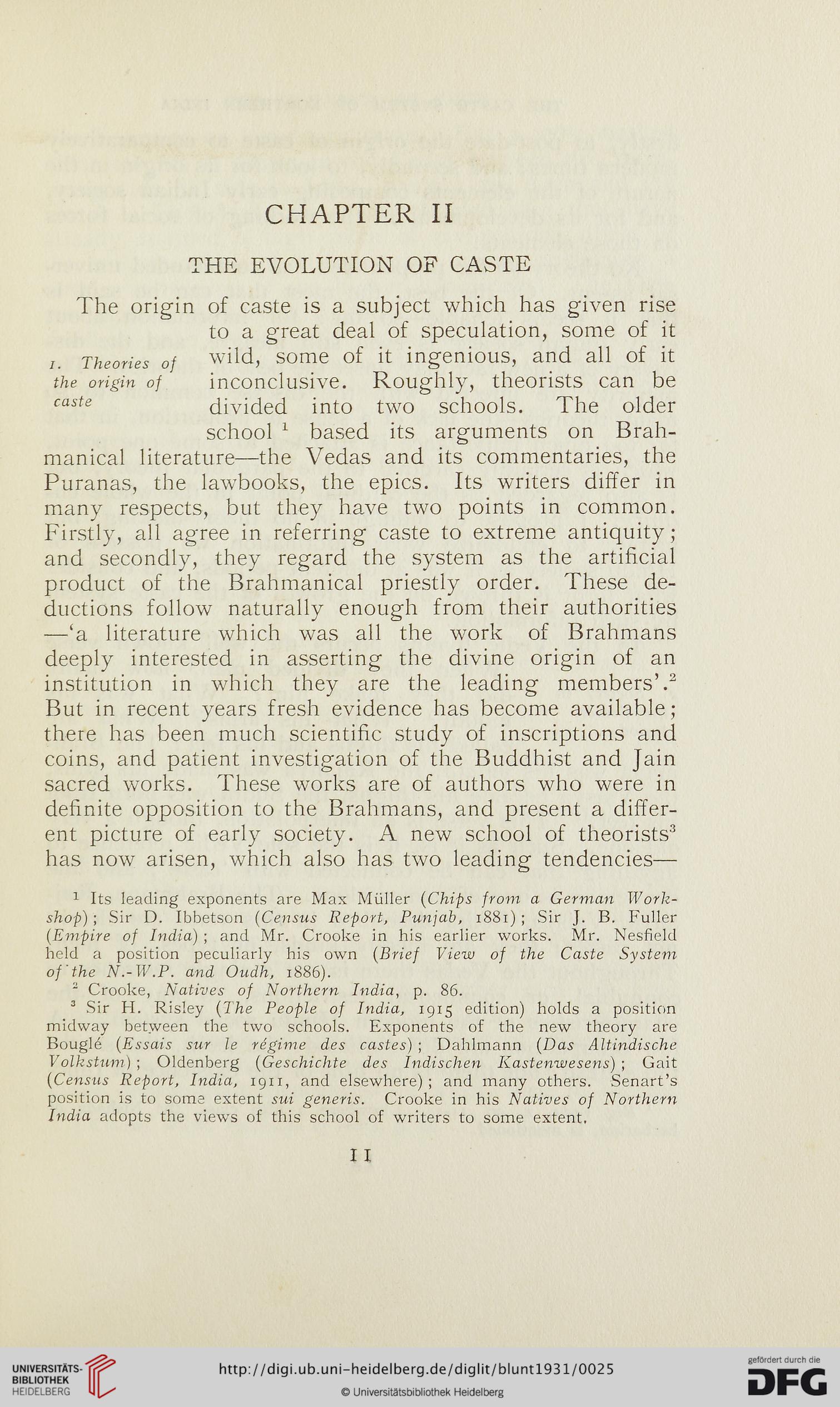CHAPTER II
THE EVOLUTION OF CASTE
The origin of caste is a subject which has given rise
to a great deal of speculation, some of it
i. Theories of wild, some of it ingenious, and all of it
the origin of inconclusive. Roughly, theorists can be
caste divided into two schools. The older
school 1 based its arguments on Brah-
manical literature—the Vedas and its commentaries, the
Puranas, the lawbooks, the epics. Its writers differ in
many respects, but they have two points in common.
Firstly, all agree in referring caste to extreme antiquity;
and secondly, they regard the system as the artificial
product of the Brahmanical priestly order. These de-
ductions follow naturally enough from their authorities
—‘a literature which was all the work of Brahmans
deeply interested in asserting the divine origin of an
institution in which they are the leading members’.2
But in recent years fresh evidence has become available;
there has been much scientific study of inscriptions and
coins, and patient investigation of the Buddhist and Jain
sacred works. These works are of authors who were in
definite opposition to the Brahmans, and present a differ-
ent picture of early society. A new school of theorists3
has now arisen, which also has two leading tendencies—
1 Its leading exponents are Max Miiller (Chips from a German Work-
shop) ; Sir D. Ibbetson {Census Report, Punjab, 1881) ; Sir J. B. Fuller
(Empire of India) ; and Mr. Crooke in his earlier works. Mr. Nesfield
held a position peculiarly his own (Brief View of the Caste System
of'the N.-W.P. and Oudh, 1886).
2 Crooke, Natives of Northern India, p. 86.
3 Sir H. Risley (The People of India, 1915 edition) holds a position
midway between the two schools. Exponents of the new theory are
Bougle (Essais sur le regime des castes) ; Dahlmann (Das Altindische
Volkstum) ; Oldenberg (Geschichte des Indischen Kastenwesens) ; Gait
(Census Report, India, 19x r, and elsewhere) ; and many others. Senart’s
position is to some extent sui generis. Crooke in his Natives of Northern
India adopts the views of this school of writers to some extent.
THE EVOLUTION OF CASTE
The origin of caste is a subject which has given rise
to a great deal of speculation, some of it
i. Theories of wild, some of it ingenious, and all of it
the origin of inconclusive. Roughly, theorists can be
caste divided into two schools. The older
school 1 based its arguments on Brah-
manical literature—the Vedas and its commentaries, the
Puranas, the lawbooks, the epics. Its writers differ in
many respects, but they have two points in common.
Firstly, all agree in referring caste to extreme antiquity;
and secondly, they regard the system as the artificial
product of the Brahmanical priestly order. These de-
ductions follow naturally enough from their authorities
—‘a literature which was all the work of Brahmans
deeply interested in asserting the divine origin of an
institution in which they are the leading members’.2
But in recent years fresh evidence has become available;
there has been much scientific study of inscriptions and
coins, and patient investigation of the Buddhist and Jain
sacred works. These works are of authors who were in
definite opposition to the Brahmans, and present a differ-
ent picture of early society. A new school of theorists3
has now arisen, which also has two leading tendencies—
1 Its leading exponents are Max Miiller (Chips from a German Work-
shop) ; Sir D. Ibbetson {Census Report, Punjab, 1881) ; Sir J. B. Fuller
(Empire of India) ; and Mr. Crooke in his earlier works. Mr. Nesfield
held a position peculiarly his own (Brief View of the Caste System
of'the N.-W.P. and Oudh, 1886).
2 Crooke, Natives of Northern India, p. 86.
3 Sir H. Risley (The People of India, 1915 edition) holds a position
midway between the two schools. Exponents of the new theory are
Bougle (Essais sur le regime des castes) ; Dahlmann (Das Altindische
Volkstum) ; Oldenberg (Geschichte des Indischen Kastenwesens) ; Gait
(Census Report, India, 19x r, and elsewhere) ; and many others. Senart’s
position is to some extent sui generis. Crooke in his Natives of Northern
India adopts the views of this school of writers to some extent.





